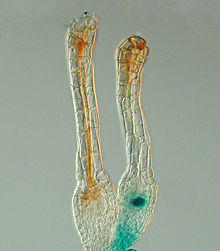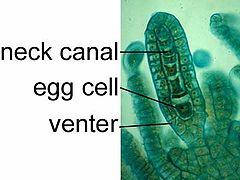An archegonium (pl: archegonia), from the ancient Greek ἀρχή ("beginning") and γόνος ("offspring"), is a multicellular structure or organ of the gametophyte phase of certain plants, producing and containing the ovum or female gamete. The corresponding male organ is called the antheridium. The archegonium has a long neck canal or venter and a swollen base. Archegonia are typically located on the surface of the plant thallus, although in the hornworts they are embedded.
Bryophytes
In bryophytes and other cryptogams sperm reach the archegonium by swimming in water films, whereas in Pinophyta and Angiosperms the pollen are delivered by wind or animal vectors and the sperm are delivered by means of a pollen tube.

In the moss Physcomitrella patens, archegonia are not embedded but are located on top of the leafy gametophore (s. Figure). The Polycomb protein FIE is expressed in the unfertilized egg cell (right) as the blue colour after GUS staining reveals. Soon after fertilisation the FIE gene is inactivated (the blue colour is no longer visible, left) in the young embryo.[1][2]
Gymnosperms
They are much-reduced and embedded in the megagametophytes of gymnosperms. The term is not used for angiosperms or the gnetophytes Gnetum and Welwitschia because the megagametophyte is reduced to just a few cells, one of which differentiates into the egg cell. The function of surrounding the gamete is assumed in large part by diploid cells of the megasporangium (nucellus) inside the ovule. Gymnosperms have their archegonium formed after pollination inside female conifer cones (megastrobili).[3]
References
- ^ Assaf Mosquna, Aviva Katz, Eva L. Decker, Stefan A. Rensing, Ralf Reski, Nir Ohad (2009): Regulation of stem cell maintenance by the Polycomb protein FIE has been conserved during land plant evolution. Development 136, 2433-2444. [1]
- ^ The Polycomb gene FIE is expressed (blue) in unfertilised egg cells of the moss Physcomitrella patens (right) and expression ceases after fertilisation in the developing diploid sporophyte (left). In situ GUS staining of two female sex organs (archegonia) of a transgenic plant expressing a translational fusion of FIE-uidA under control of the native FIE promoter. "Archived copy". Archived from the original on 2009-06-26. Retrieved 2009-07-03.
- ^ Brooklyn Botanic Garden
